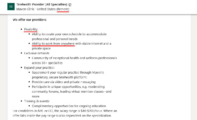With CEOs increasingly issuing return-to-office mandates and remote work advocates saying not so fast, managers can be forgiven for feeling confused.
Many bosses feel that their younger employees, in order to grow and absorb the company culture, need in-person guidance and a chance to connect with other workers. Meanwhile many senior employees, especially ones with kids, feel that working from home is actually more effective in their case.
One problem with today’s return-to-office debates is that they often lump these two very different types of employees together, believes Hung Lee, the writer and founder of the Recruiting Brainfood newsletter.
“We’ve treated things monolithically, and sometimes we need to make generalizations, of course, in order to have a conversation,” he said in an a16z podcast episode published this week. “But we’re probably at the point now where we need to bring in the nuance because what is positive for one group of people is negative for another.”
He pointed to an iCIMS report’s survey showing that, among university seniors entering the workforce, fully remote work held little appeal. Only 2% of them said they wanted such an arrangement. Nearly 60% said they don’t have all the equipment they need at home, and a third said they lack a dedicated workspace. Nearly 90% said they wanted to frequently meet in person with coworkers to build relationships and network.
If you look at companies that were already successfully remote-first before the pandemic, they tended to avoid such employees and instead focused on senior workers with plenty of experience, Lee noted. Today, “the people who are most pro-remote—the remote evangelists, so to speak—they are all of that demographic,” he said. “They are individual contributors who have established a level of expertise.”
Such workers have typically already built up social capital and have an effective workspace at home, he noted, and often have children they want to be near: “They don’t feel they need to come to the office in order to make friends.”
By contrast, younger workers might live with roommates or their parents or perhaps feel isolated in a small apartment and crave the opportunity to connect face-to-face with colleagues. Venture capitalist Marc Andreessen, cofounder of Andreessen Horowitz, believes remote work has “detonated” the way we connect, with younger workers suffering the most. “You get to sit in your studio apartment in front of your laptop and good luck—you’re cut off from everything else,” he said at a summit last November.
Return-to-office backlash
Many companies are settling on a hybrid schedule, with employees asked (or required) to work in the office three or four days a week. It isn’t always going smoothly. Amazon recently saw an employee walkout over its return-to-office mandate, and last month workers at Google let their displeasure be known.
“There is a bit of a tension at this point where some companies are rolling back the remote policies, or at least they’re starting to put additional conditions upon it, which you can see it’s kind of a mission creep back to the office,” said Lee.
He believes that power is swinging back toward employers, who are seeing “an opportunity to claw back some of what they may have always perceived to be an overly permissive position when it comes down to working remote.”
Either way, when “building a company or designing an organization,” employee demographics have to be kept in mind, Lee says. “If we are absolutely a remote-first company, we are probably optimized as an employer for a senior individual contributor that has already achieved a certain degree of material comfort.”








































